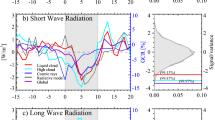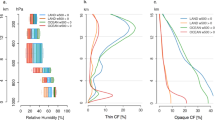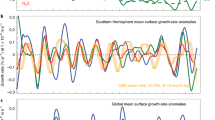Abstract
The hydroxyl free radical, OH, is sunlight's prime agent in maintaining the trace-gas composition of the Earth's troposphere, and at the same time serves as the catalyst responsible for many of the symptoms of urban and regional air pollution. We have used low-pressure fluorescence to measure the ambient concentration of this radical during two continuous 36-hour periods in early summer and late autumn, 1985. The summer and autumn maxima were 3 × l06 and 4 × l05 molecules cm−3 (10−13 and 2 × l0−14 relative to air), respectively. The observed concentrations lie within the rather large latitude of Current estimates based on trace-gas lifetimes or atmospheric photochemical models.
This is a preview of subscription content, access via your institution
Access options
Subscribe to this journal
Receive 51 print issues and online access
$199.00 per year
only $3.90 per issue
Buy this article
- Purchase on Springer Link
- Instant access to full article PDF
Prices may be subject to local taxes which are calculated during checkout
Similar content being viewed by others
References
Khalil, M. A. K. & Rasmussen, R. A. Science 232, 56–57 (1986).
Rinsland, C. P., Levine, J. S. & Miles, T. Nature 318, 245–249 (1985).
Stauffer, B., Fischer, G., Neftel, A. & Oeschger, H. Science 229, 1386–1388 (1985).
Hewitt, C. N. & Harrison, R. N. Atmos. Envir. 19, 545–554 (1985).
Wang, C. C. & Davis, L. I. Geophys. Res. Lett. 9, 98–100 (1981).
Davis, D. D., Fischer, S. D. & Rodgers, M. O. Geophys. Res. Lett. 9, 101–104 (1982).
Hard, T. M., O'Brien, R. J., Chan, C. Y. & Mehrabzadeh, A. A. Envir. Sci. Technol. 18, 768–777 (1984).
Atkinson, R., Darnall, K. R., Lloyd, A. C., Winer, A. M. & Pitts, J. N. Jr Adv. Photochem. 11, 375–487 (1979).
Perry, R. A., Atkinson, R. & Pitts, J. N. Jr J. phys. Chem., Ithaca 81, 296–304 (1977).
Finlayson-Pitts, B. J. & Pitts, J. N. Jr Angew. Chem. 14, 1–14 (1975).
Niki, H., Daby, E. E. & Weinstock, H. Adv. Chem. Ser. 113, 16–42 (1972).
Crutzen, P. J. & Gidel, L. T. J. geophys. Res. 88, 6641–6661 (1983).
Logan, J. A., Prather, M. J., Wofsy, S. C. & McElroy, M. B. J. geophys. Res. 86, 7210–7254 (1981).
Graedel, T. E., Farrow, L. A. & Weber, T. A. Atmos. Envir. 10, 1095–1101 (1976).
Calvert, J. G. Envir. Sci. Technol. 10, 256–262 (1976).
Singh, H. B. Geophys. Res. Lett. 4, 453–456 (1977).
Volz, A., Ehhalt, D. H. & Derwent, R. G. J. geophys. Res. 86, 5163–5171 (1981).
Author information
Authors and Affiliations
Rights and permissions
About this article
Cite this article
Hard, T., Chan, C., Mehrabzadeh, A. et al. Diurnal cycle of tropospheric OH. Nature 322, 617–620 (1986). https://doi.org/10.1038/322617a0
Received:
Accepted:
Issue Date:
DOI: https://doi.org/10.1038/322617a0
This article is cited by
-
Tropospheric OH and stratospheric OH and Cl concentrations determined from CH4, CH3Cl, and SF6 measurements
npj Climate and Atmospheric Science (2018)
-
Conversion rates of surface HOx radicals in Beijing City
Chinese Geographical Science (2004)
-
HO x production due to radon decay in air
Journal of Atmospheric Chemistry (1993)
-
Spectroscopic measurement of free radicals (OH, NO3) in the atmosphere
Fresenius' Journal of Analytical Chemistry (1991)
-
Prototype FAGE determination of NO2
Journal of Atmospheric Chemistry (1991)
Comments
By submitting a comment you agree to abide by our Terms and Community Guidelines. If you find something abusive or that does not comply with our terms or guidelines please flag it as inappropriate.



